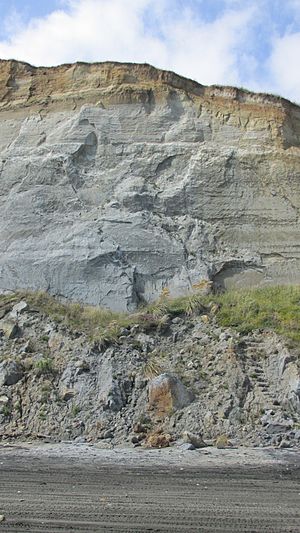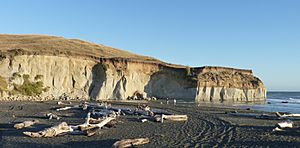Wanganui Basin facts for kids
The Wanganui Basin (also called Whanganui Basin) is a special area in New Zealand, on the North Island. It's like a big bowl, partly on land and partly under the sea. This basin holds amazing clues about Earth's past. It helps scientists learn about the ocean and its creatures from millions of years ago.
Contents
Where is the Wanganui Basin?
The Wanganui Basin is on the west coast of the North Island of New Zealand. It stretches across the Manawatū-Whanganui and Taranaki areas. The basin looks a bit like an oval. It is about 180 kilometers (112 miles) long and 100 kilometers (62 miles) wide.
About half of this basin is on land. It reaches inland near the Whanganui and Rangitikei Rivers. It stops at the base of the North Island Volcanic Plateau. The other half of the basin goes out into the ocean, into the South Taranaki Bight. The main city in this area is Whanganui, which is located along the coast.
What is the Geology of the Wanganui Basin?
The Wanganui Basin is very important for studying Earth's history. It has one of the most complete records of ocean layers from the last few million years. This makes it a key place for geologists and fossil experts to do their research.
Understanding Earth's Timeline
The Wanganui Basin is so important that it gives its name to a part of the New Zealand geologic time scale. This part is called the Wanganui epoch. It covers a huge period of time, from about 5.33 million years ago until today. This includes the Pliocene, Pleistocene, and Holocene periods.
A famous scientist named Charles Fleming first studied this time period in detail. He connected the layers in the basin to Earth's past ice ages. His work has greatly helped scientists understand how our planet has changed over time. Each smaller time period within the Wanganui epoch is named after places in the Wanganui Basin.
Important Study Locations
Scientists often visit specific spots in the Wanganui Basin to learn more. Two well-known places are:
- Castlecliff
- Nukumaru
What Fossils are Found Here?
The rocks and dirt in the Wanganui Basin are full of amazing fossils. These are mostly from sea creatures that lived in shallow ocean waters. You can find many types of molluscs (like snails and clams) and bryozoans (tiny sea animals).
Some of the most common fossil shells found belong to clams called Dosinia and Chlamys. You can also find many fossil snail shells from types like Zethalia and Murex. Other frequent snail fossils include Aeneator, Buccinulum, Penion, Alcithoe, and Amalda. These fossils help scientists understand what the ancient oceans were like.



